The QNAP TS-364 NAS Drive Review
QNAP are now very much in the process of slowly rolling out their new Prosumer and SMB series for 2022, but when it comes to the unit that they are slowly releasing, you can definitely see that they are being a great deal smarter (tactically) than previous generations. Alongside the release of the NVMe focused TBS-464 back in late October, the next unit in this series to arrive is the incredibly unique and unusual QNAP TS-364 NAS Drive. Today I want to review this rather different NA system and ultimately answer three main questions, 1) Is this a suitable alternative to a 2/4-Bay? 2) Is this TOO niche, even for a subject that is already as niche as NAS? And 3) Ultimately does it deserve your data? This 3x Hard drive and 2x NVMe SSD system (that 2nd storage detail is always way, way too overlooked) is formed in a similar shape to the previous 3-Bay systems before it but also arrives with the latest choices in internal/external hardware architecture that we have grown to expect in 2021/2022 from QNAP. With some users who look at 2-Bay solutions and the 50% storage loss of RAID 1 as a dealbreaker, whilst still looking at 4-Bay systems as capacity and price based overkill, is a 3-Bay NAS drive such as the TS-364 from QNAP what you have been searching for all this time? Let’s review the QNAP TS-364 and decide if this system is just right OR just a little too niche? Let’s go.
QNAP TS-364 NAS Review – Quick Conclusion
Once again, QNAP (in my opinion of course) are still very much the true innovators of the NAS hardware industry, seemingly exploring and almost always delivering on solutions that change what we expect private home/business servers to look like, support and provide. The TS-364 3-Bay (TECHNICALLY 5-Bay if you want to be accurate about it) has one heck of a balancing act to perform, providing more than the typical 2-Bay desktop chassis like the TS-253D and TS-264 are promising, whilst not leaning TOO heavily on the TS-453D and TS-464 to make itself or those redundant in price or approach. I think it MOSTLY sticks the landing and what you have here is the best example of this series that QNAP has ever produced, managing to balance the price point and value just right. In my introduction, I asked three questions. 1) Is this a suitable alternative to a 2/4-Bay? – It DEFINITELY is a good option, for those that are stuck between the rock and a hard place of 2 or 4 bays! 2) Is this TOO niche, even for a subject that is already as niche as NAS? – No, I think this system provides a valuable and till-now often overlooked section of the buying market. And 3) Ultimately does it deserve your data? – I think if you are a 2-Bay buyer, then spending the tiny bit extra for this 3-Bay is a no brainer, but if you are looking at 4-Bays, then the 3-Bay TS-364 might lack the extra storage potential, PCIe upgrades and base level connectivity long term of current prosumer 4-Bays like the TS-453D and TS-464. Overall, I like what the TS-364 is offering here and I think it fits well in the QNAP portfolio and solutions available to the end user.
| Where to Buy a Product | |||
|
|
    
|

|
VISIT RETAILER ➤ |
 |
    
|

|
VISIT RETAILER ➤ |
 |
    
|

|
VISIT RETAILER ➤ |
 |
    
|

|
VISIT RETAILER ➤ |
QNAP TS-364 NAS Review – PACKAGING & ACCESSORIES
The retail box of the QNAP TS-364 NAS is fairly standard stuff, with the typical brown box design and a product-specific label. It is at this tier that a solution will almost exclusively be an eShop/Online only purchase, so therefore any concerns about packaging will be much more geared towards protection in transit from movement and shock damage. On that score, I would stay that the less than usual shaped TS-364 NAS chassis is well protected.
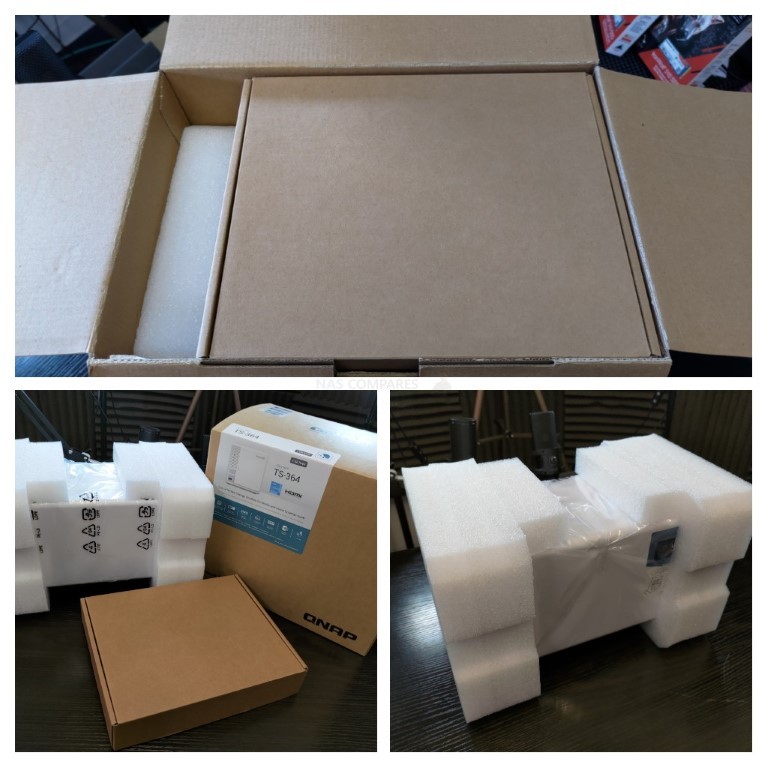
The TS-364 NAS chassis itself arrives in quite an impressive surrounding of hard foam from all corners. Indeed, this foam takes up more than 40% of the retail box and will amply protect this unit virtually completely in it’s transit from Taiwan to..well.. everywhere. Alongside the TS-364 unit itself, there is also a box of accessories in a separate kit carton.
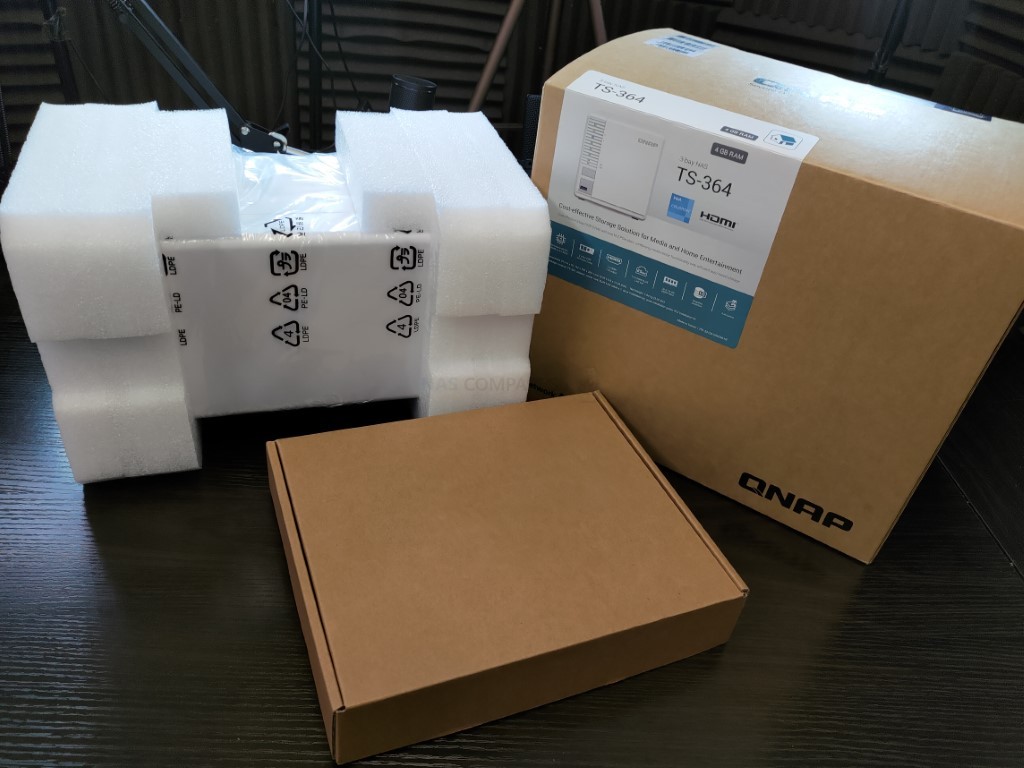
The accessories that are included with the TS-364 are fairly typical of QNAP (with a small exception) and are pretty much everything you are going to need in order to get started with your NAS (with the exception of HDD/SSD media that you will need to buy separately).

The TS-364 features an external power supply unit, likely for reasons of space, easy replacement and maintaining better internal temperatures. The external PSU on this rather modest-sized NAS arrives is 65W and QNAP state that it has been recorded at 32.8W power use when in active use – this includes the internal fan in operation at all times.
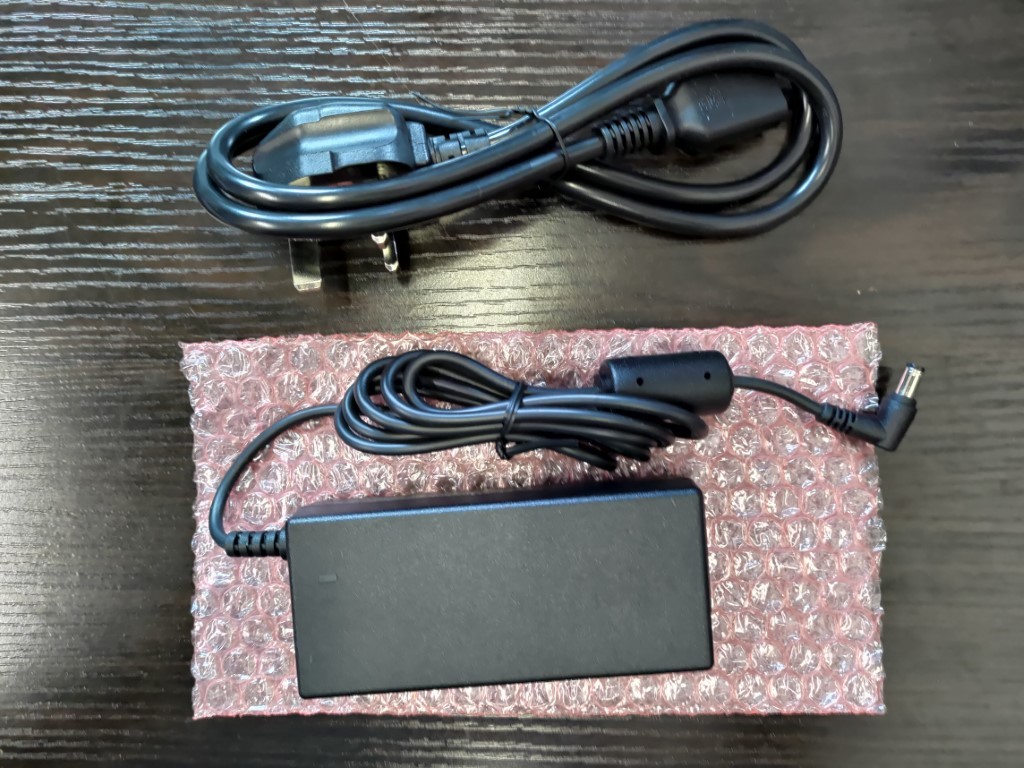
The TS-364 also features the support of both Hard Drives and M.2 NVMe SSDs, something I will cover in more detail later. The accessory kit arrives with additional click’n’load HDDs install pods and two M.2 SSD heatsink panels that are adhesive-backed and designed to be applied directly onto the controller of any installed NVM.e SSDs in the NAS allocated bays.
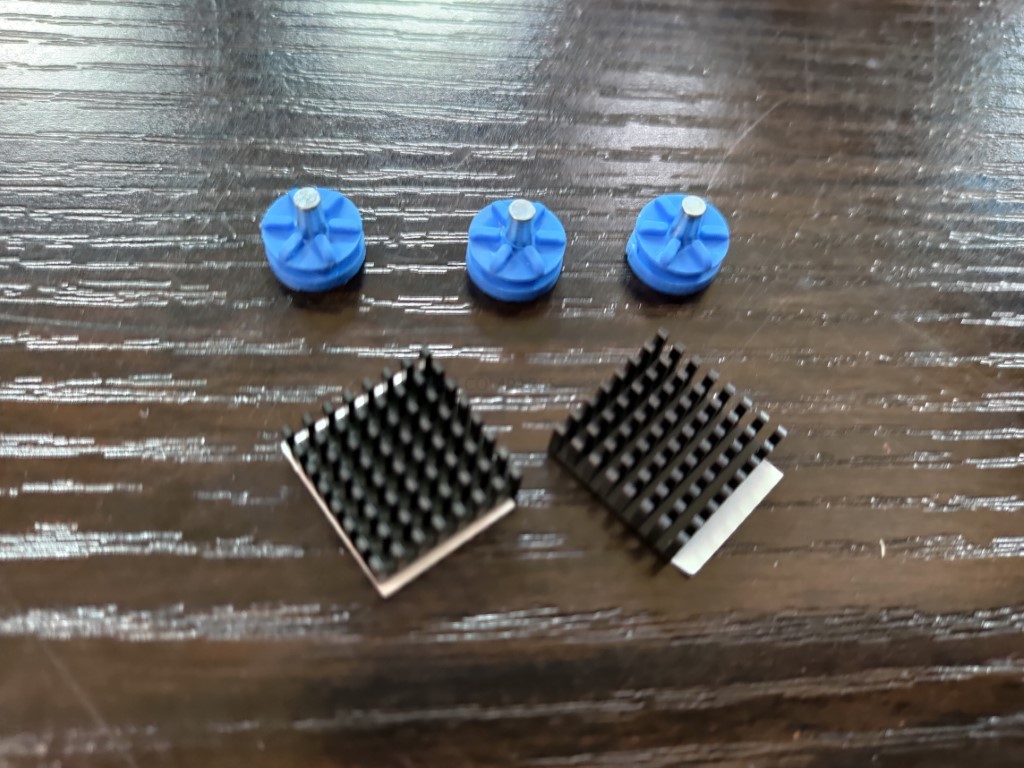
As glad as I am that QNA has included heatsinks for the M.2 slot media that you might install in the TS-364, these are remarkably small and a bit underwhelming. On the one hand, the space for the M.2 bays inside the TS-364 is a little small, but there is still amply space for a larger full-2280 length heatsink. Whether this smaller m.2 heatsink is being provided because of space, overall active system temp provisioning or as it is a general part on their production line – it’s still a bit of an underwhelming inclusion, as in a heavy use 24×7 environment, I am unsure how effective these will be.
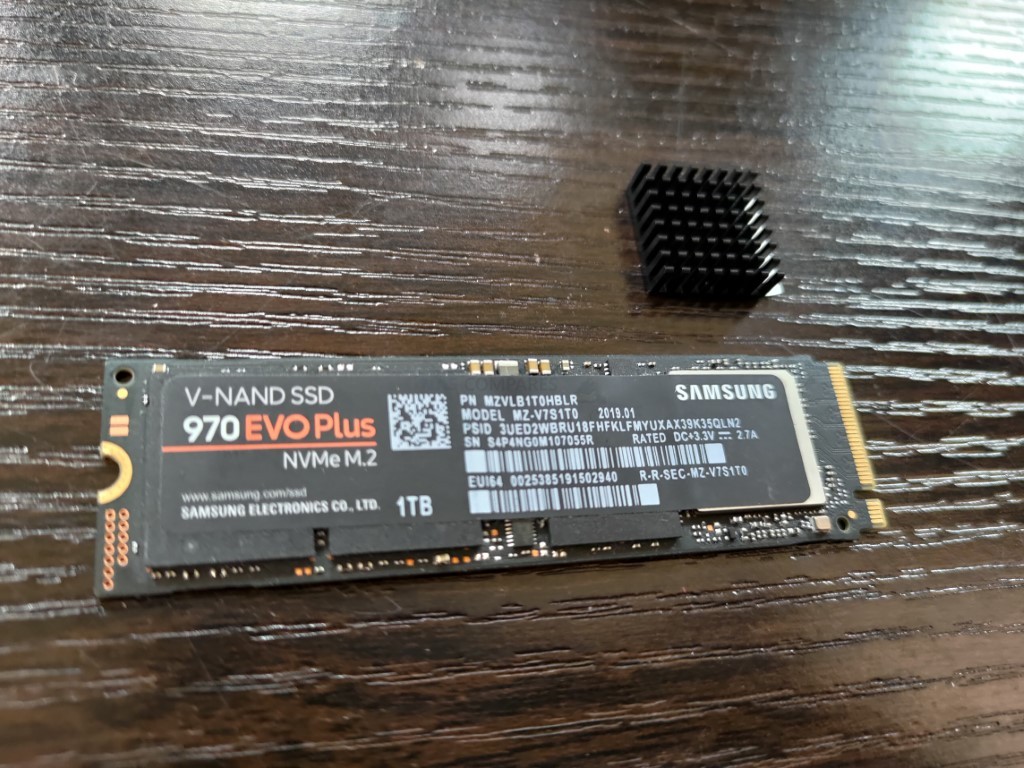
Overall, I am happy with the compact presentation and accessories, though I wonder how protected it is when shipped fully populated. Let’s take a look at the design of the QNAP TS-364 NAS.
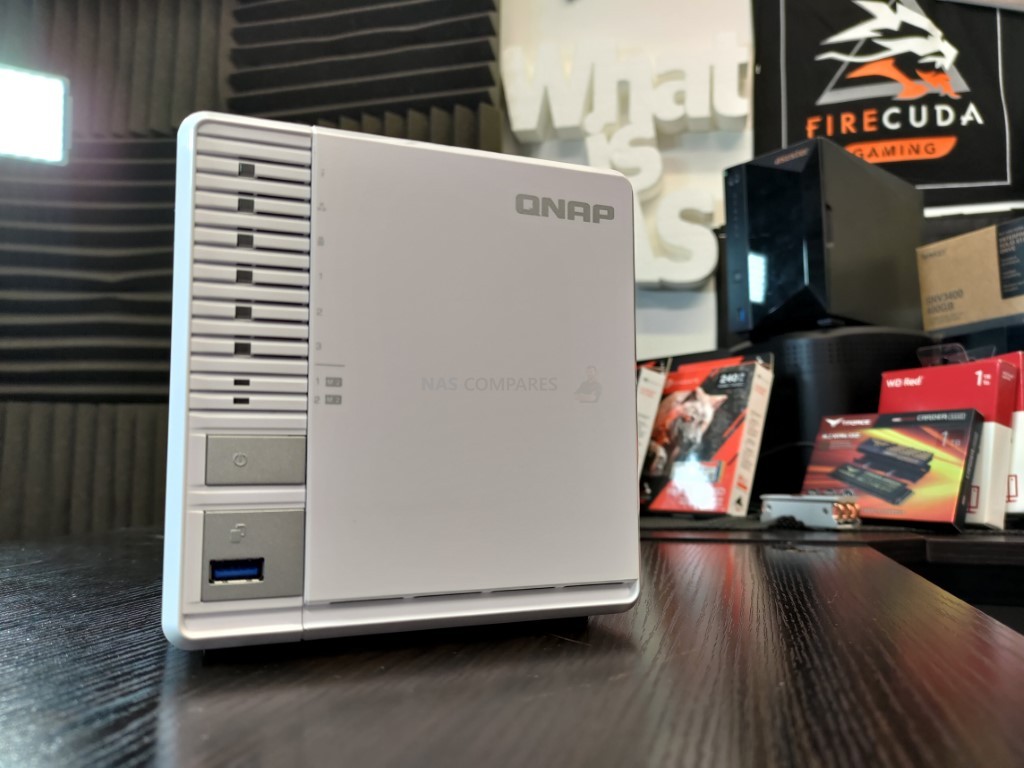
QNAP TS-364 NAS Review – Design
The external chassis of the TS-364 is a rather unusual one that will almost certainly split opinion. For a start, it manages to be both smaller AND bigger than both your average 2-Bay and 4-Bay. As peculiar as that statement might sound, let me explain.
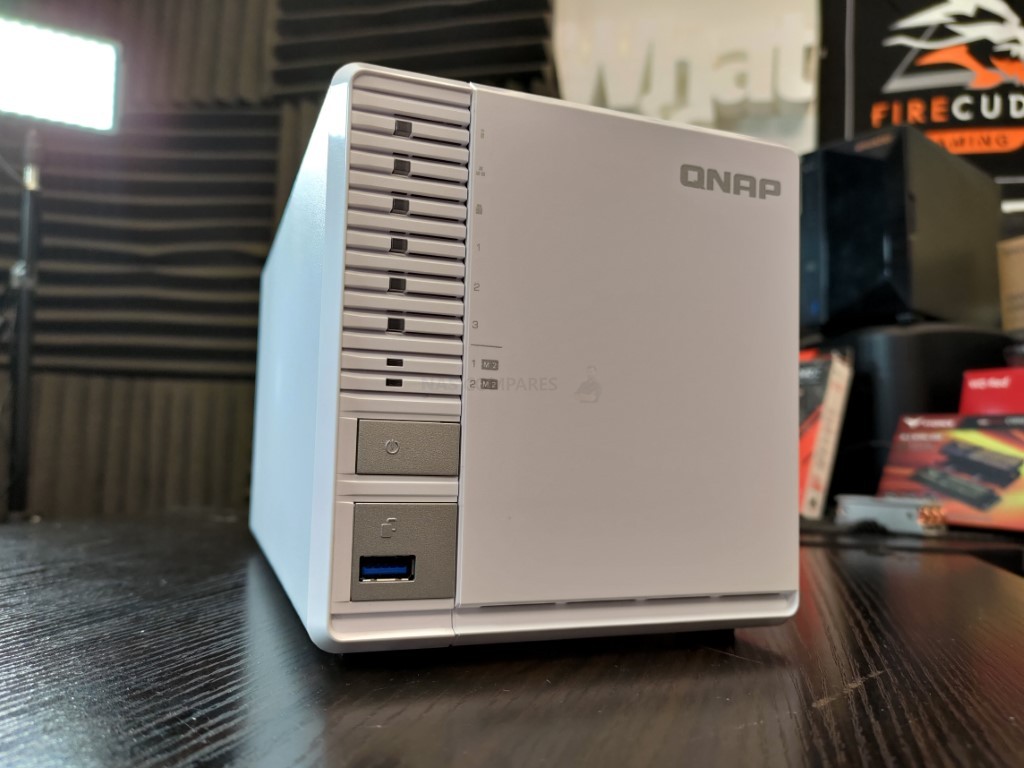
The front of the TS-364 NAS chassis is an almost perfect square, at 142mm x 150mm – shorter than more 2-Bay NAS systems that stack their HDD media vertically internally, as well as narrower than a 4-Bay that has that extra HDD bay. However, in depth/length, it’s a different story as the TS-364 is 260mm deep – that is noticeably deeper than more other desktop NAS chassis (even most 8-Bay systems). This is because the system clearly uses a vertically airflow system, which draws air through the system using a system of front-mounted vent holes and a large rear active fan. There are no holes/vents on the sides, in order to maintain and capitalize on this active airflow.
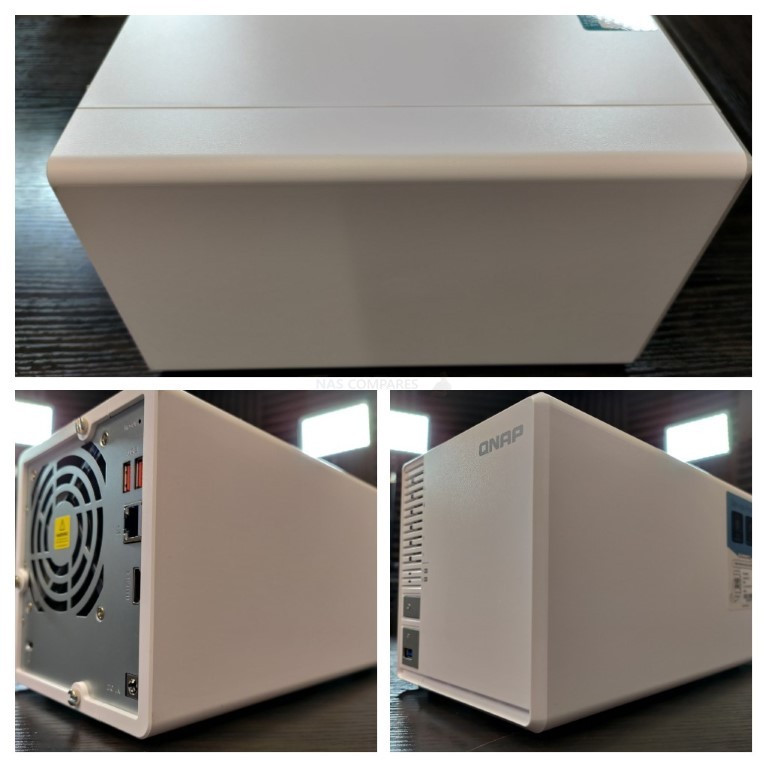
Alot of the ventilation o nthe front is surprisingly well hidden. The LED panel on the front of the device (which has lights that indicate system access, network activity, HDD health, HDD health and connectivity) neatly surrounds the larger side vent panel very well.
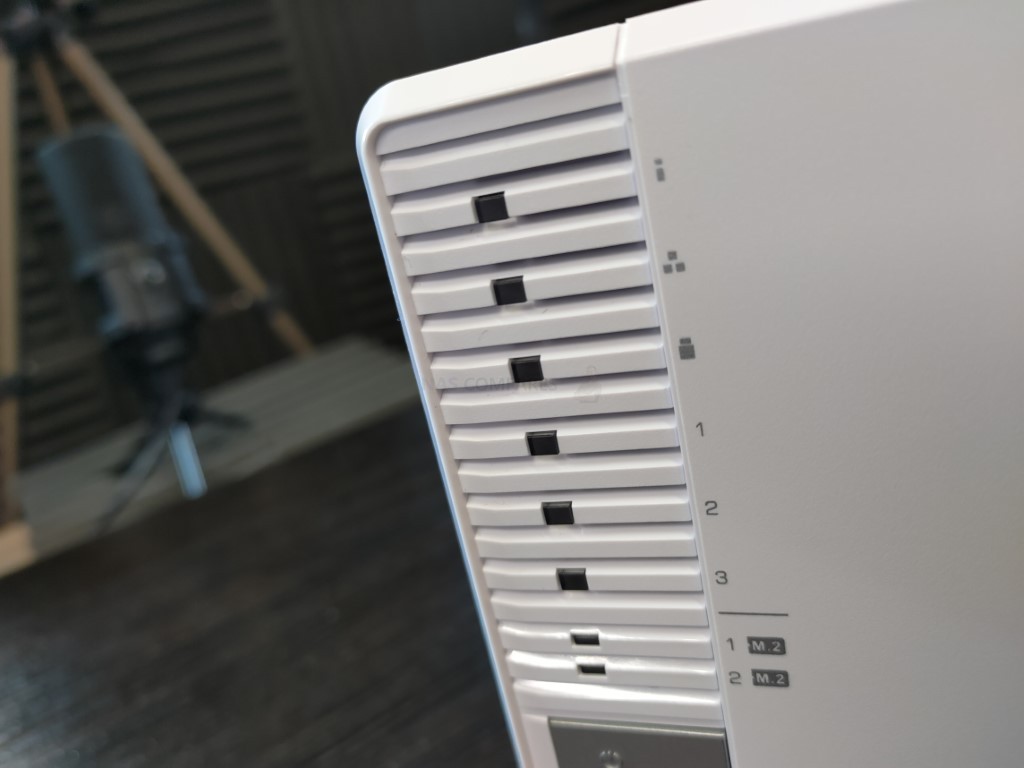
It is only when you angle the chassis up that the ventilation on that front panel under the LEDs is exposed, as well as the base level vents under the HDD media bays and those that are going to pass air directly over the m.2 SSD bays. It’s a neat design move.
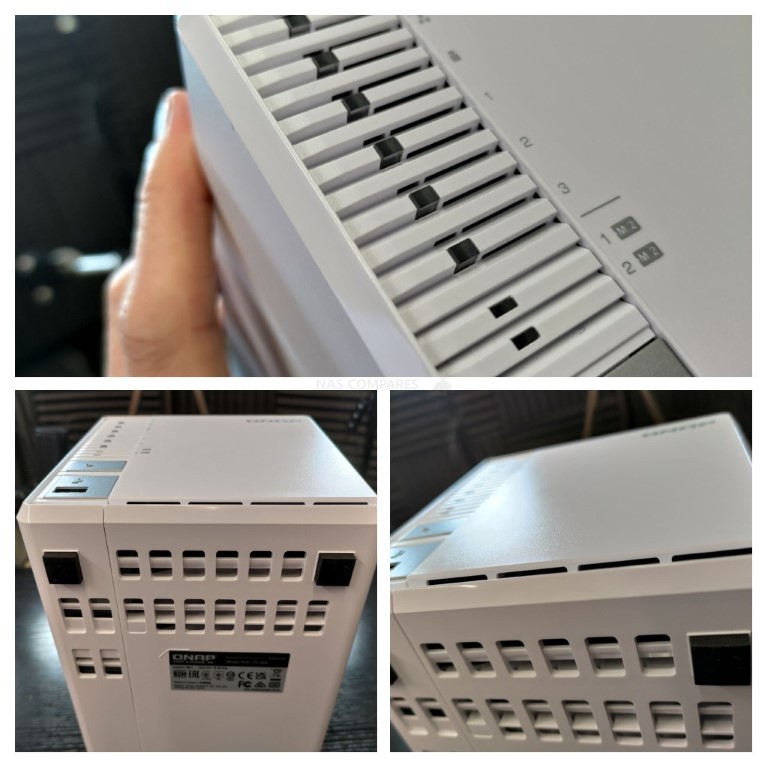
The actual chassis design itself might look a bit retro/naff for some and the plastic, white choice in colour/materials is another area that some might not be enormously keen on, but you cannot really fault the venting choices here. Likewise, if this chassis had been metal, it would have noticeably increased the ambient noise level. It is already reported at 20.5 bd(A) which is already higher than when I had it in operation for Plex and software testing – coming soon), so overall I like the design choices here.
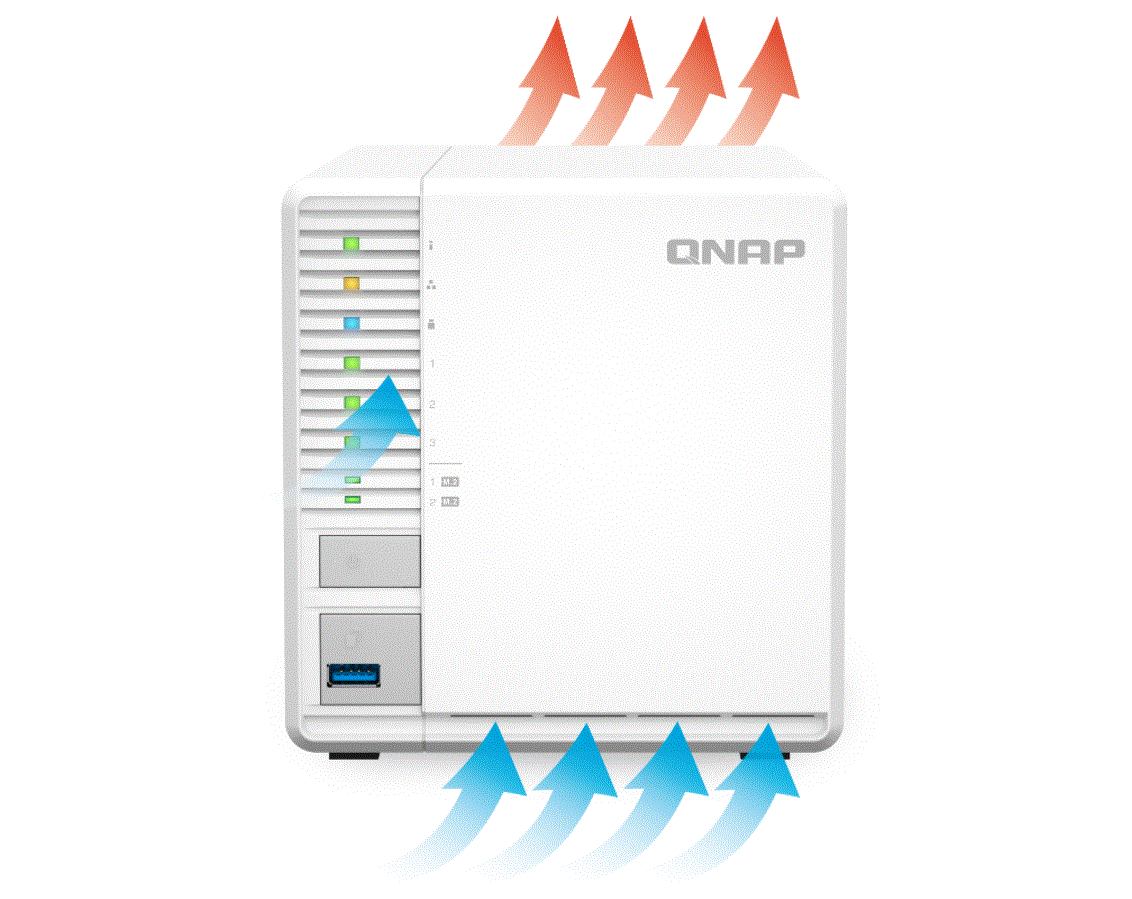
The TS-364 also features a useful front-mounted USB 3.2 Gen 1 (5Gb/s) port that can be used for local backups (either direction), peripheral devices, network upgrades (up to 5GbE too, over USB, using QNAP’s own adapter) and more. I have always championed this remarkably underestimated and old skool’ connection of desktop devices and am pleased that this rather compact system still features it.
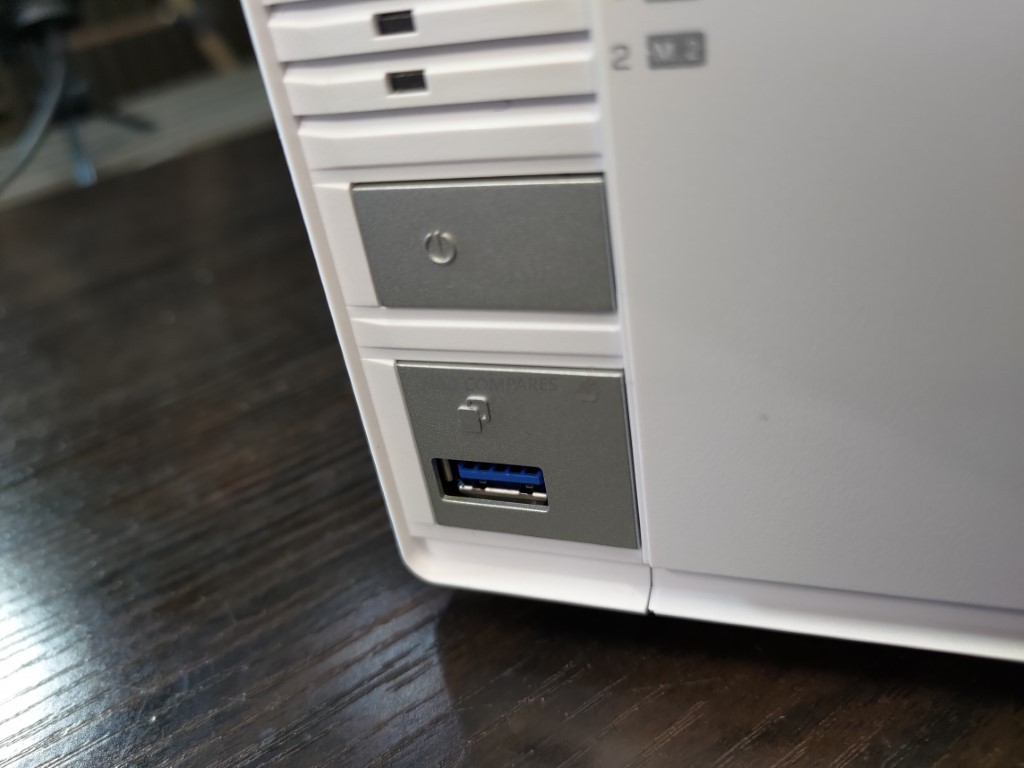
The overall design of the TS-364 is going to be of little importance to those that plan on setting up the devices in an unseen corner/attic/storage room – but for those that want to desk mount the system nearby, perhaps directly connecting using the aforementioned USB-to-5GbE adapter for high speed local work might find the TS-364’s oddly long shape to be problematic. Still, for what it is trying to achieve and in order to facilitate three hard drive bays and cool 2 M.2 NVMe bays, I think the system did the right thing. Now, let’s talk connectivity.
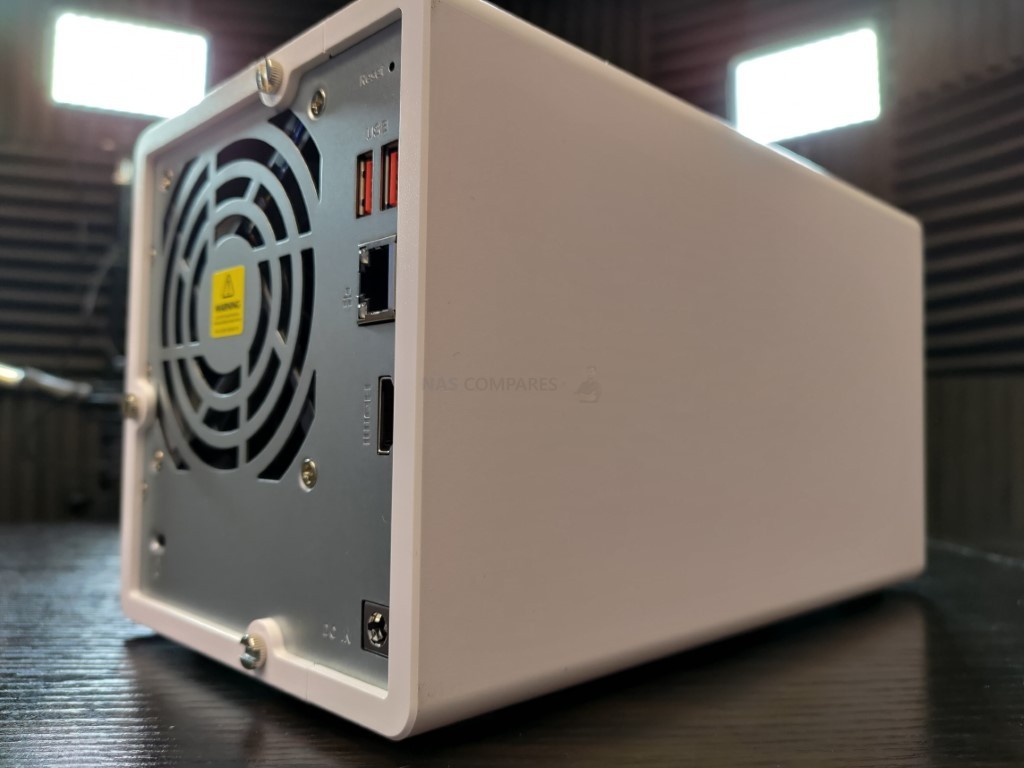
QNAP TS-364 NAS Review – Ports & Connections
The connectivity of the TS-364 NAS is something that I think falls somewhere between ‘good stuff’ and ‘just enough’. Remember that QNAP is currently the only brand to have a featured series of 3-Bay devices in their portfolio to fill a surprisingly user-ready middle ground between prosumer and business storage users. Alot of the external connectivity’s good and ‘meh’ comes down to those pesky CPU PCI lanes again. The fact that in order to maintain a good price vs performance point, brands tend to rely on Intel Celeron processors at this tier. These processors have a decent enough level of PCI lanes to spread across storage bays and connectivity, but it is still a finite amount. The result is that those two internal M.2 bays result in a tiny amount of ‘wing clipping’ in the external connectivity. Let’s go through them in a bit, but first, back to cooling!
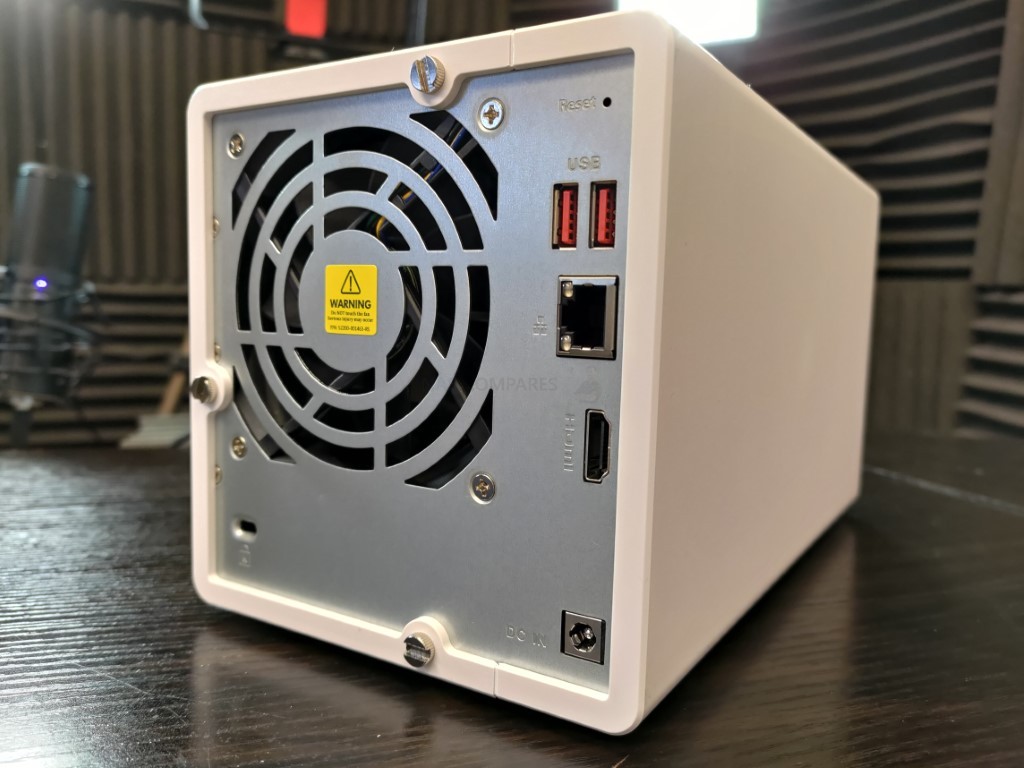
As mentioned earlier, the TS-364 internal temperature handling comes down to well-placed vents, well placed internal heatsinks and that rear fan. The TS-364 features a 92mm single rear fan that takes up over 50% of the rear of the chassis, DIRECTLY behind those SATA HDD storage bays. It’s RPM can be adjusted of course, but it is recommended to leave it on automatic. Even in very light usage, any particularly noticeably noise came from the HDD media more than the fan.
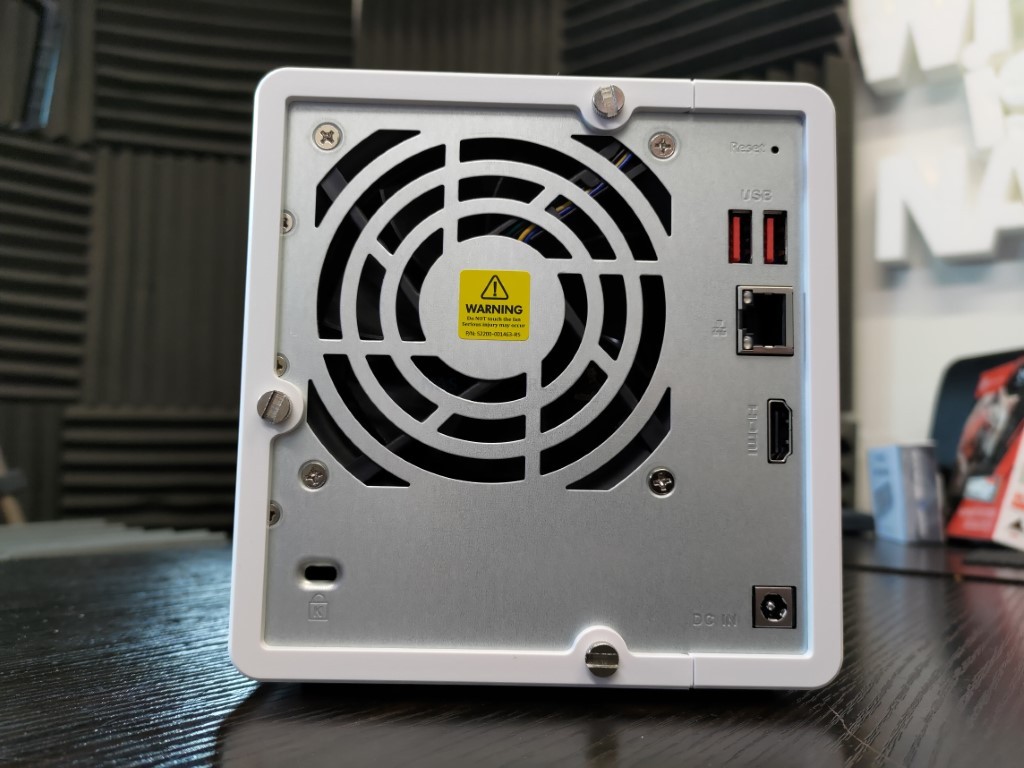
The first cool thing in connectivity is that the TS-364 is one of the first Prosumer/lite-SMB solutions from QNAP at this scale that includes USB 3.2 gen 2 (10Gb/s) ports. Both are USB Type A and support everything from my powerful USB accessories and tools, to external storage drives of up to 1,000MB/s. It’s a bit odd that this is not the USB on the front of the chassis with 1-touch copying (where someone who regularly but ad hoc connects a drive for work/school to backup FAST), but better to have it than not at all.
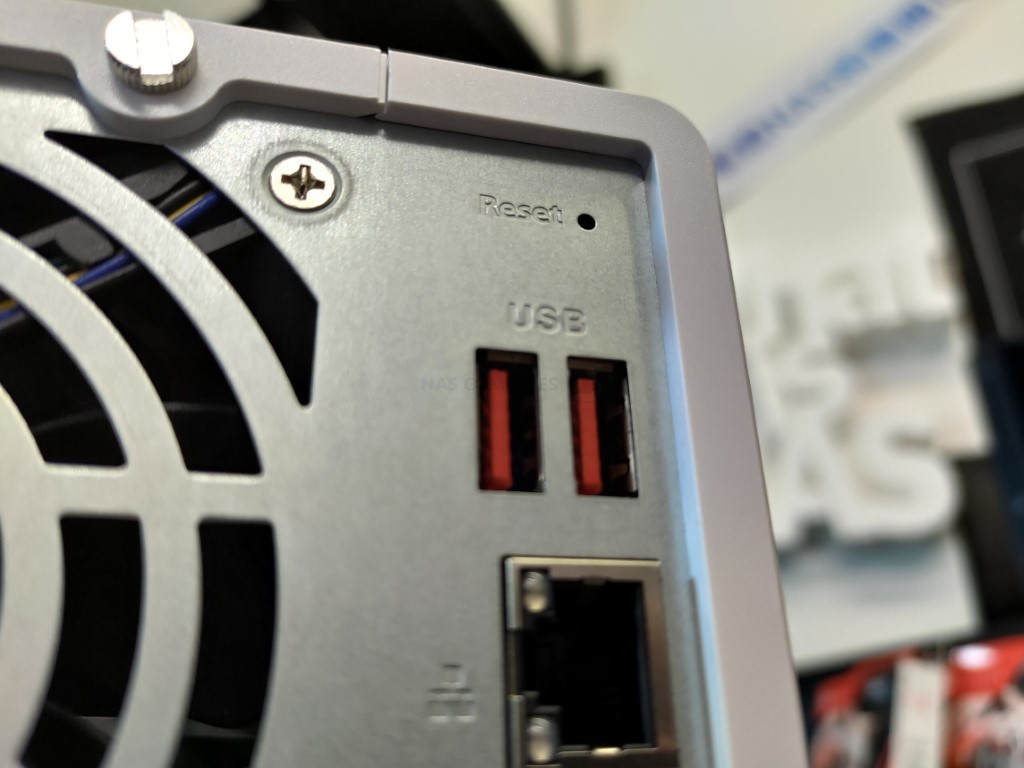
Another nice connection choice is the default 2.5GbE network port on the TS-364. QNAP has pretty much set 2.5x standard gigabit connectivity as the standard on 80-85% of their hardware and almost certainly it will be 100% in the next year or so. The act that this is arriving at the same price point at 1GbE means, as well as being completely backwards compatible is a definite bonus.
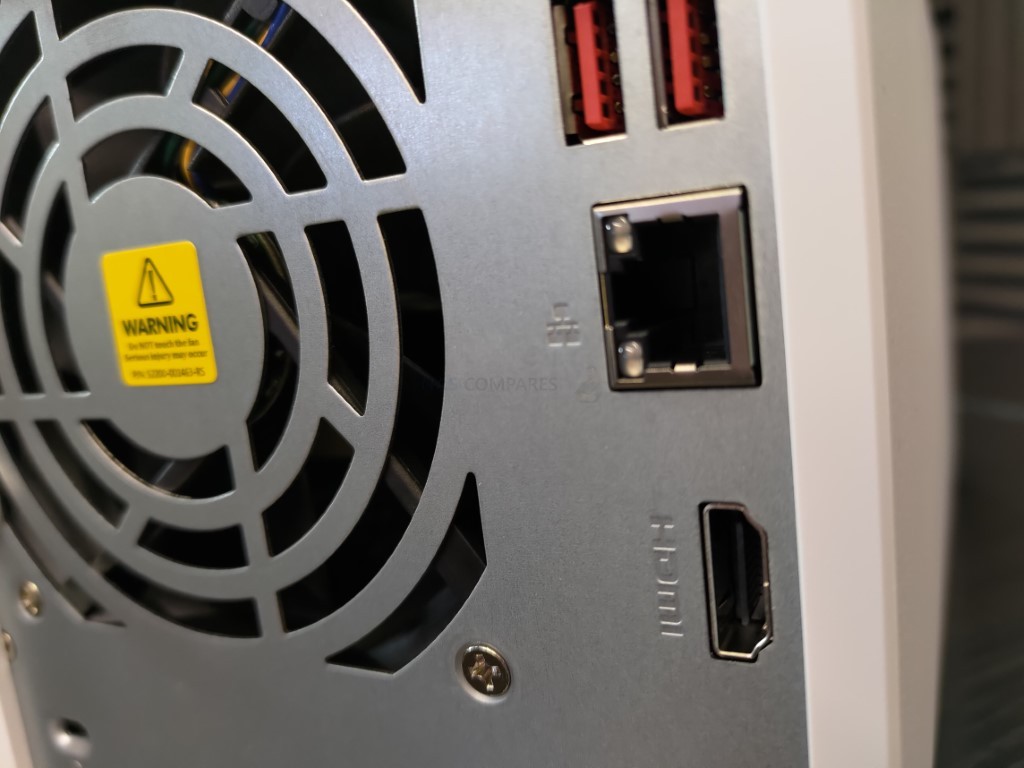
There is the minor complaint that it is a single ethernet port (not the 2x 2.5G on the TBS-464 or the 2x ports that will almost certainly arrive in the likes of the TS-264, TS-262 or even TS-x53E series at some point far into the future no doubt), but again, at this price point, it’s a tough complaint to keep up with. Below is the reported maximum by QNAP in this connection, but also it is a shame that this system lacks the 10GbE (SFP+) port of the TS-332X before it. Though this is likely that blasted CPU PIC limitation again, plus the TS-332X had a shocking weaker CPU by comparison.

The QNAP TS-364 also features an HDMI output, much like the rest of the SMB Intel-powered devices from QNAP. This means that the system can support a parallel GUI via an HDMI TV or monitor, as well as Keyboard, Video Mouse (KVM) support with the use of USB wired peripherals, Bluetooth adapter connected wireless peripherals and several network remote controls (plus the QNAP QRemote application for Android and iOS). The TS-364 features HDMI 1.4b, so 1080p at 60FPS and 4K at 30FPS, which is a slight downgrade on the HDMI 2.0 available on other TS-x64 NAS systems revealed so far.
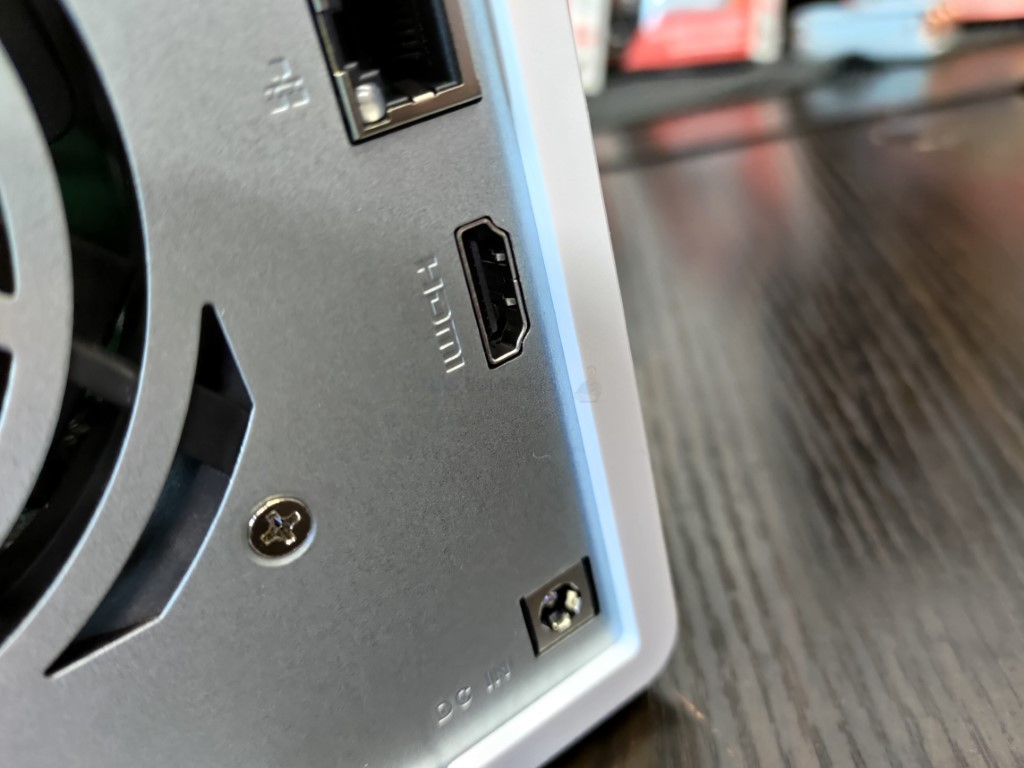
I am working on a 2021/2022 revisit of HD Station from QNAP, but below is the Setup guide and overview of the application from last year that still covers a lot of the platforms abilities and features:
The external connectivity of the TS-364 is a good mix of useful, if somewhat safe choices by QNAP. I like what is here but the bits that shine do seem to have the tiniest pinch of compromise about them (2.5G but a single port, 10G USB but not on the front, HDMI but 1.6b rev). Let’s open up this NAS system and take a look at media drive installation and those internal hardware specifications.
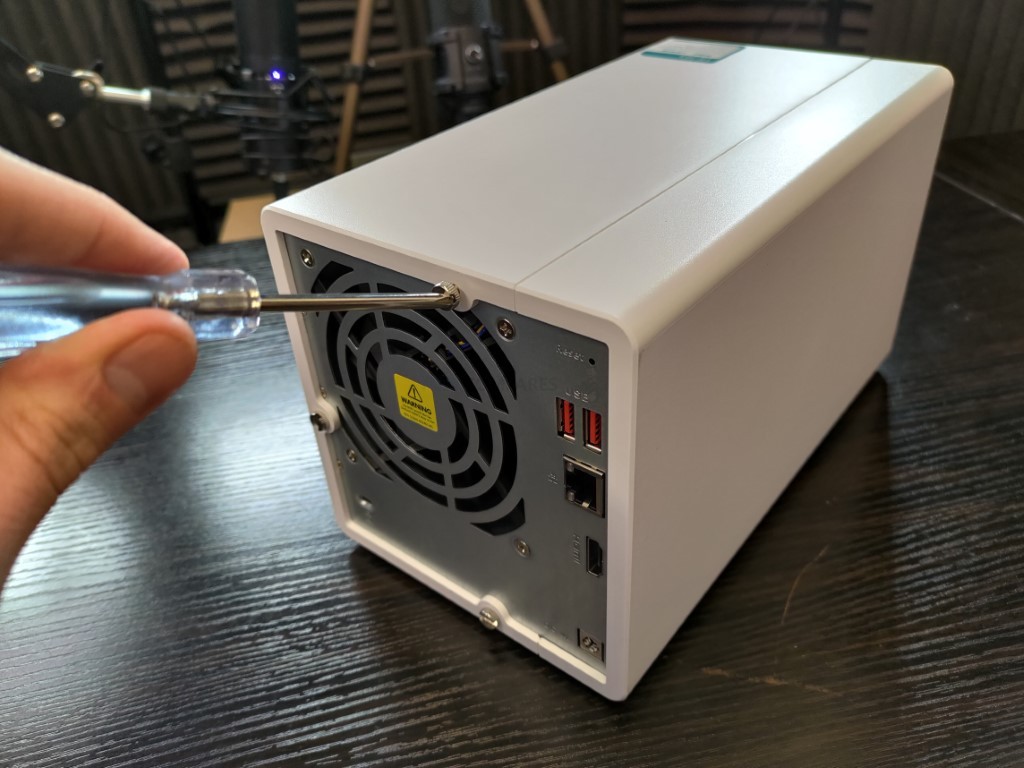
Accessing the inside of the TS-364 is easy, with the removal of three rear screws, the chassis comes apart in two halves, revealing the internal storage bays, the memory upgrade slots and the Intel Celeron CPU inside. Let’s discuss that internal hardware in detail.
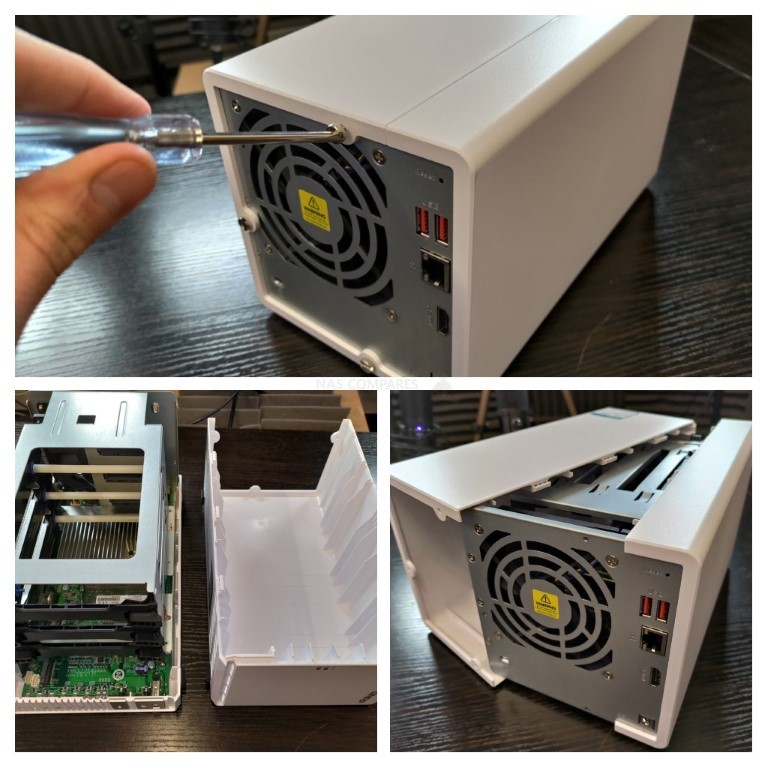
QNAP TS-364 NAS Review – Internal Hardware
The TS-364 does not support any kind of hot swapping, as it does not use external removable trays. Instead, it features the three SATA storage media bays in a cage arrangement, with the two m.2 SSD media bays, SODIMM memory slots and CPU+heatsink neatly located underneath in the fan’s air path.
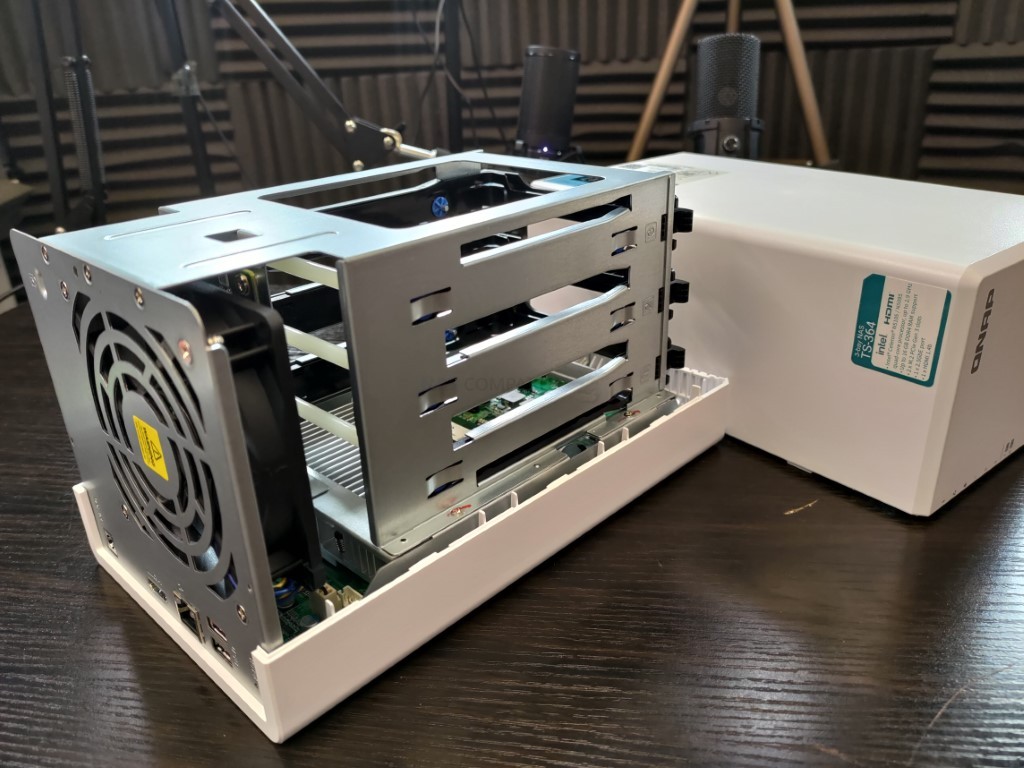
The three SATA hard Drive trays do not require a screw driver to install the media, though installation of SATA SSDs is going to prove difficult/impossible without an adapter. The trays themselves are also a little flimsier than those found in a system that supports hot-swapping (i.e removal whilst the system is in operation).
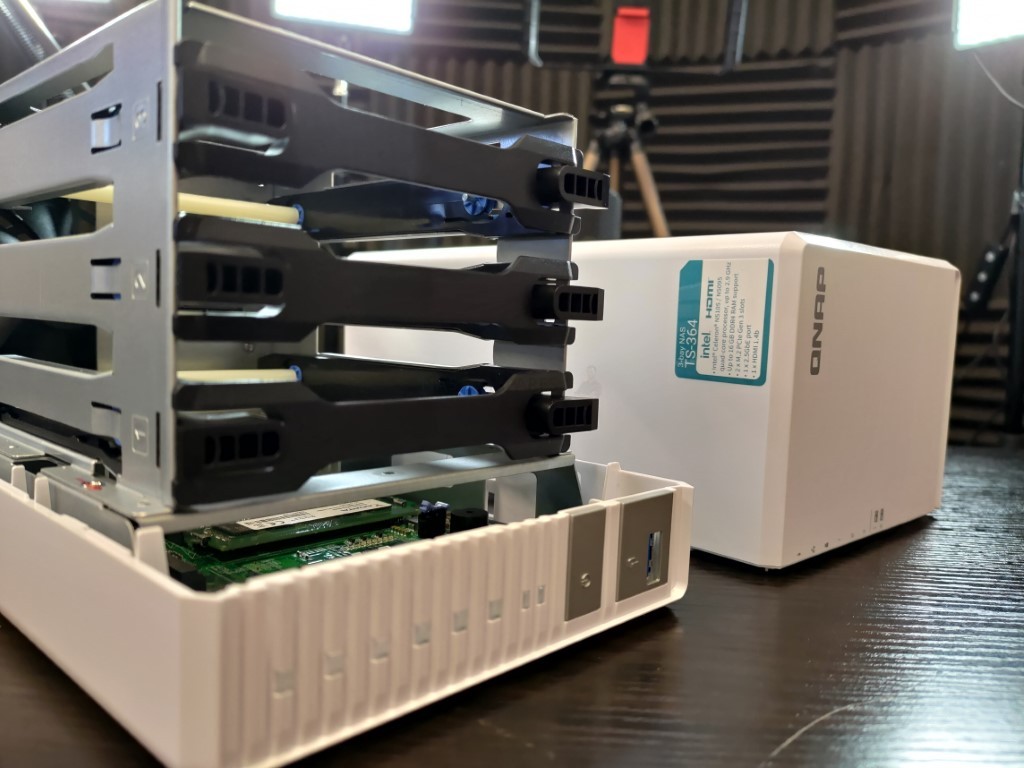
The trays are a U shaped surround that features four-pin clips each that hold the 3.5″ SATA Hard drive in place. Clearly the usual trays that QNAP use in their system’s would be unsuitable large in this chassis, but these still feel a little underwhelming. Your TS-364 NAS can be operated with as little as a single HDD inside, but with all three bays populated you can take advantage of RAID configurations like RAID 5 for a better balance of storage, performance and redundancy (i.e a safety net if a drive dies). The latest 18TB and 20TB drives slot neatly into the chassis, which means a potential 60TB of raw HDD storage can be achieved in the TS-364 – for such a small physical size and just three bays of storage – that IS impressive!
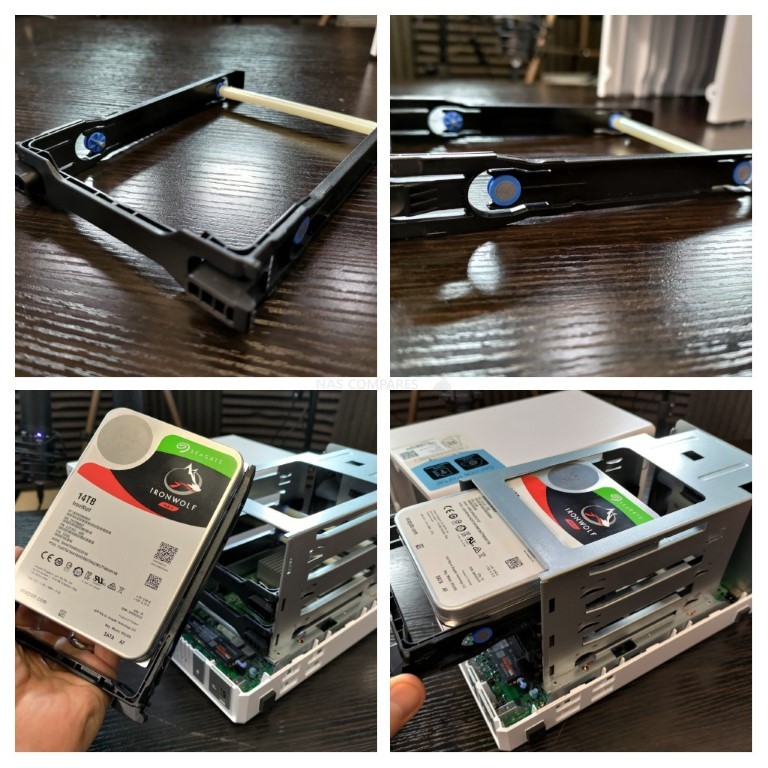
Revisiting the subject of CPU PCI lanes leads to one part of the TS-364 architecture that may disappoint. Each of the M.2 NVMe SSD slots is PCIe Gen 3 x2 in bandwidth. This means that each slot can provide a potential 2,000MB/s of performance. However, the majority of modern PCIe Gen 3 SSDs arrive in Gen 3×4, normally hitting the 3,000-3,400MB/s performance mark. It is still great to have the flexibility of Hard Drives AND NVMe SSD, but it is still a shame that each slot has this unavoidable bottleneck internally. The fact they are included is still a HUGE bonus overall though, with the system supporting the use of these M.2 SSD bays for caching, raw storage pools or tiered storage alongside the HDDs RAID.
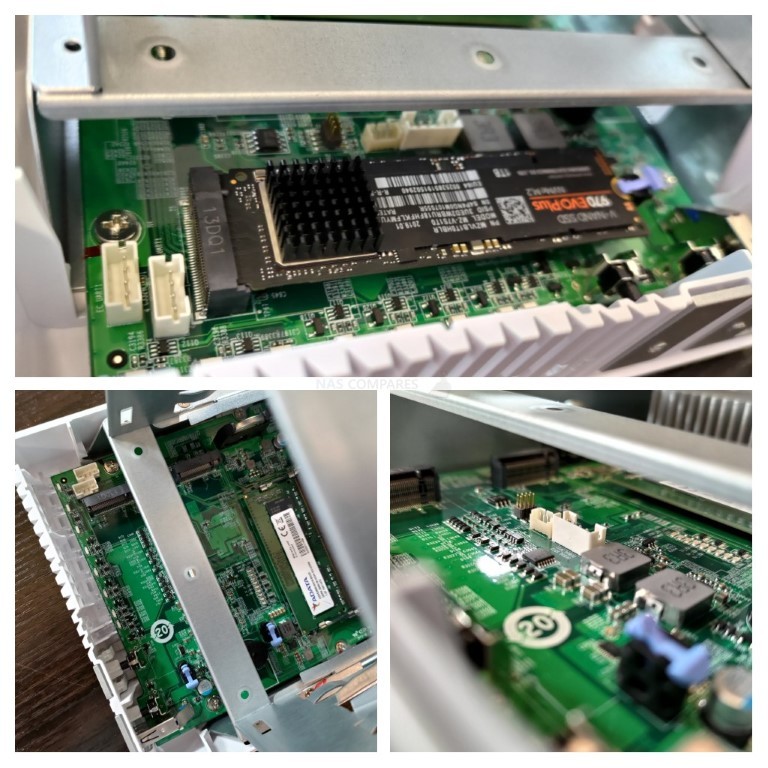
The CPU and memory used in the TS-364 are also of a good standard for a 2021/2022 Prosumer/SMB NAS release. Alongside an Intel Celeron CPU, it also arrives with 4GB of DDR4 2666Mhz memory (which can be upgraded to the maximum 16GB supported by the CPU). 4GB is still very decent about of base-level memory on this NAS and the fact that QNAP has included 2666Mhz memory (when older-gen units have always had 2400Mhz) is also a good sign for the brand’s future releases too. But the CPU is where I really want to focus.
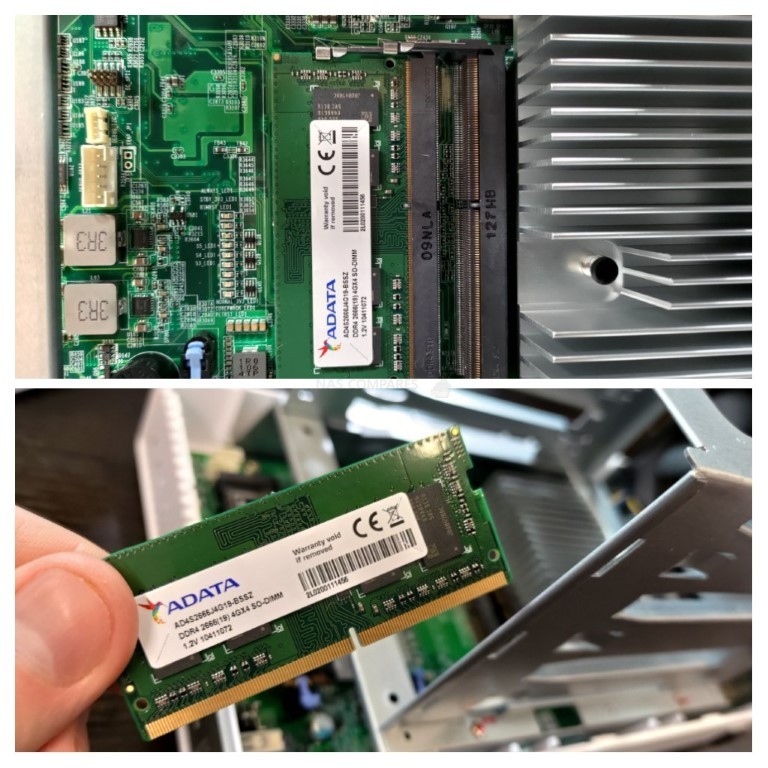
The Celeron series is one that is generally refreshed every 18-24months by Intel on their production line. However, because of semi-conductor shortages and the effects of the pandemic in 2020/2021 on production lines, the result is that the Intel Celeron series most recent revisions have been remarkably erratic and the result is that the Celeron CPU of the newest TS-x64 series from QNAP actually spans three different (but VERY similar CPUs).
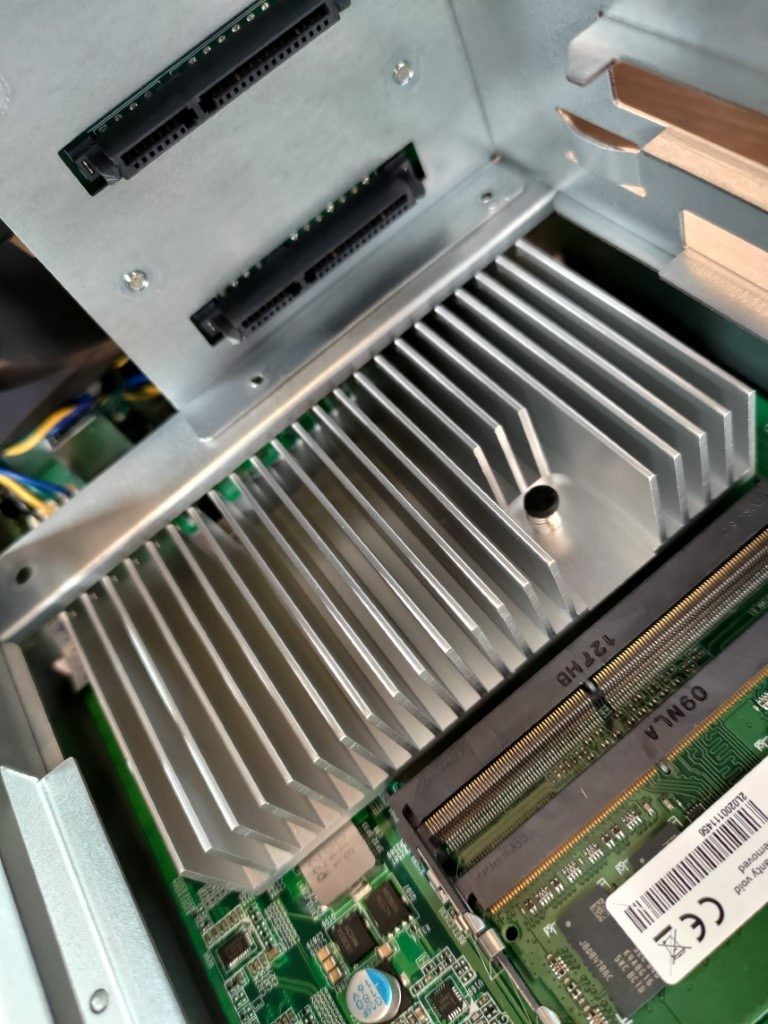
In the case of the TS-364, it arrives with the Intel N5105 or N5095. Both are 2.0Ghz in architecture that can be boosted to 2.9Ghz by the system when needed, as well as supporting on-broad graphics (so the support of transcoding and handling graphical data like 4K media and 3D images) to the same degree, AES-NI inline encryption and a great floating point. Aside from very minor differences around encoding/decoding and a slightly raised TDP (so, the amount of heat vs power draw) on the N5095, they are pretty much identical. Both are a nice jump up from the 2017/18 generation Intel Celeron J4115/J4125 that is used in the previous generation and at this price point, I am happy with this chip. Expect Plex testing and Virtual Machine testing soon.
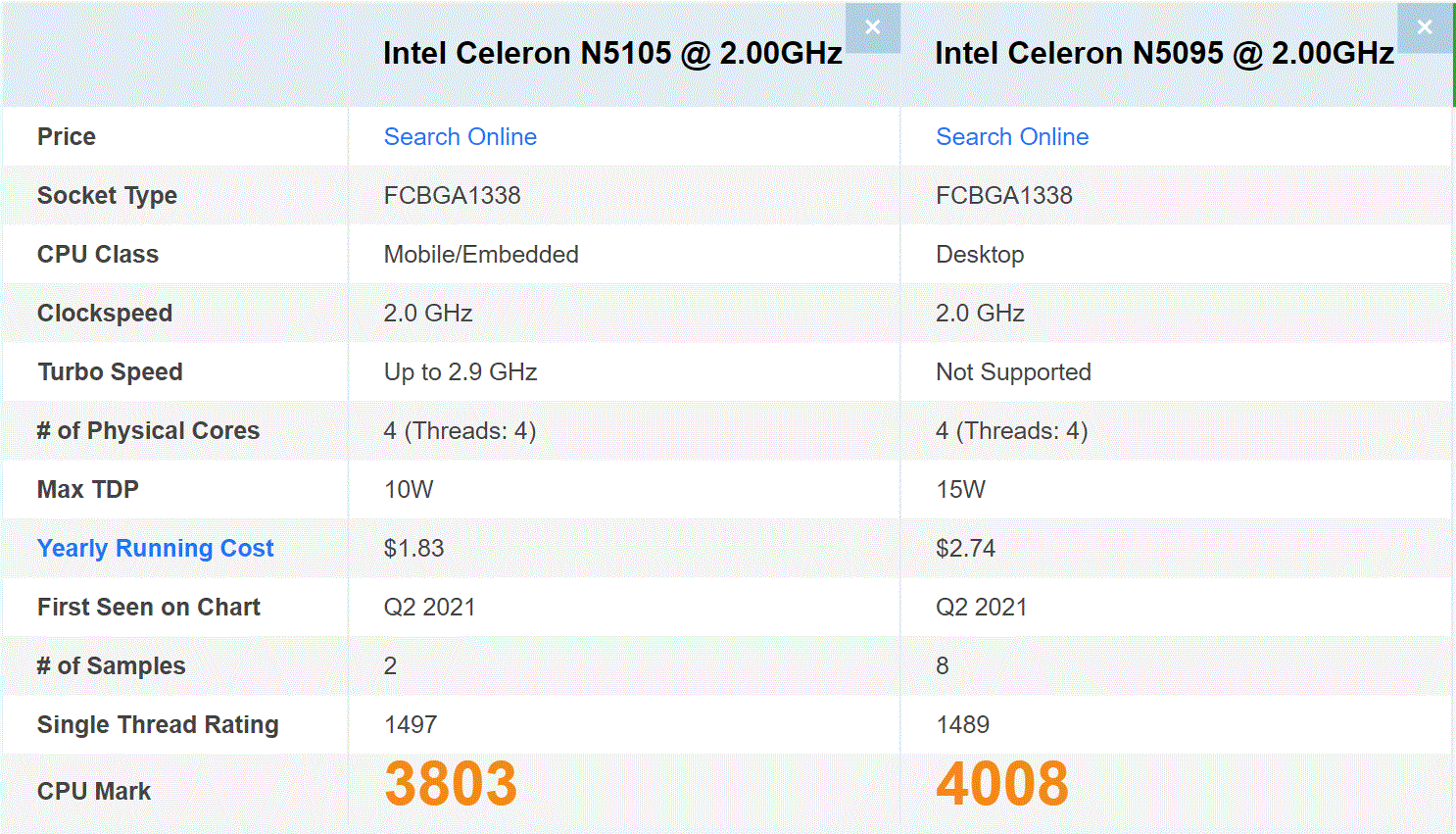
Overall, the internal architecture of the QNAP TS-364 NAS at its £350-400 price (TBC at launch), which will almost certainly be lower on most e-retailers, seems a reasonable price for the architecture here. Let’s talk a little bit about the software included with the TS-364, known as QTS 5.
QNAP TS-364 NAS Review – Software & Services
Alongside the hardware of the TS-364 NAS, you also receive the complete software and services package of QNAP QTS (currently in version 5.0). This is a complete operating system. similar in design and presentation to Android OS, it runs hundreds of applications, services and functions, as well as arriving with many mobile and desktop client applications that allow you to interact with the data on your NAS in a much more tailored way. Alongside this, the QNAP QTS software on the TS-364 also includes a few extra SSD tools for anti-wearing on the SSDs, better SSD profiling and even options to separate the media into storage, caching or tiered storage where appropriate. The performance and services of QTS have been covered many times on this channel, so reviewing it’s individual performance on the TS-364 NAS is a difficult task, as we have to look at two key things. Is QTS a good software platform and is QTS 5.0 a substantial update on QTS 4.5? On the first score, I can comfortably say that QNAP NAS software and services have truly come into their own and the balancing act of supplying the end-user with the flexibility to use the system ‘their way’, whilst still keeping it user friendly is the best it has ever been. Is it perfect, no. In its efforts to make itself customizable in every way possible, QTS develops an inadvertent learning curve that may catch some novice users unaware. Likewise, although QTS 5 has done a lot of work on its presentation of information and notifications, there is still the odd moment of ‘TMI’ when switching between services on the fly. QNAP’s NAS software is still easily one of the most adaptable in the market right now and allows users to have a truly unique storage environment if they choose and although not quite as user-friendly as Synology DSM, it counters this by being fantastically flexibly by comparison (from file/folder structure to 3rd party services support and connectivity). In order to see the extent of the latest version of QNAP TS 5.0 use the links below to the written review and video below released in late 2021:
| FULL Written QNAP QTS 5 Review | FULL Video Review of QNAP QTS 5 |
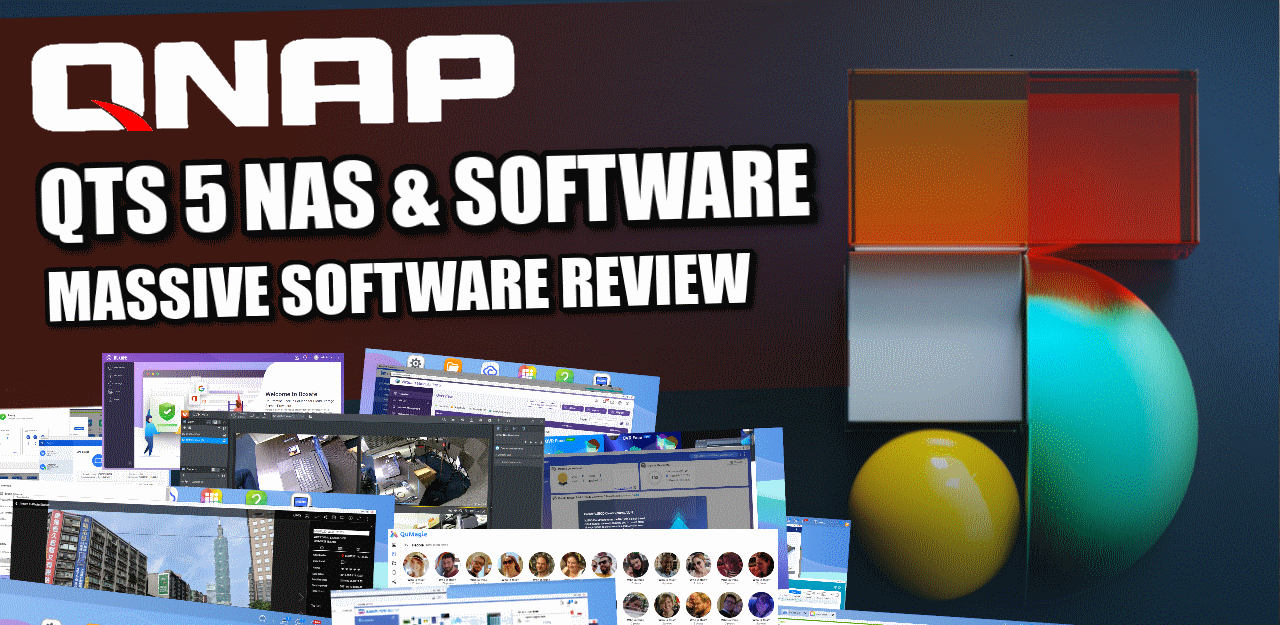 |
Tests of the QNAP TS-364 on how it performs as a Plex Media Server, host for Virtual Machines and more will be conducted shortly over on NASCompares YouTube channel. I recommend visiting there to learn more. Below is the video review for the QNAP TS-364 NAS
QNAP TS-364 NAS Review – Conclusion & Verdict
Once again, QNAP (in my opinion of course) are still very much the true innovators of the NAS hardware industry, seemingly exploring and almost always delivering on solutions that change what we expect private home/business servers to look like, support and provide. The TS-364 3-Bay (TECHNICALLY 5-Bay if you want to be accurate about it) has one heck of a balancing act to perform, providing more than the typical 2-Bay desktop chassis like the TS-253D and TS-264 are promising, whilst not leaning TOO heavily on the TS-453D and TS-464 to make itself or those redundant in price or approach. I think it MOSTLY sticks the landing and what you have here is the best example of this series that QNAP has ever produced, managing to balance the price point and value just right. In my introduction, I asked three questions. 1) Is this a suitable alternative to a 2/4-Bay? – It DEFINITELY is a good option, for those that are stuck between the rock and a hard place of 2 or 4 bays! 2) Is this TOO niche, even for a subject that is already as niche as NAS? – No, I think this system provides a valuable and till-now often overlooked section of the buying market. And 3) Ultimately does it deserve your data? – I think if you are a 2-Bay buyer, then spending the tiny bit extra for this 3-Bay is a no brainer, but if you are looking at 4-Bays, then the 3-Bay TS-364 might lack the extra storage potential, PCIe upgrades and base level connectivity long term of current prosumer 4-Bays like the TS-453D and TS-464. Overall, I like what the TS-364 is offering here and I think it fits well in the QNAP portfolio and solutions available to the end-user.
| PROs of the QNAP TS-364 NAS | CONs of the QNAP TS-364 NAS |
| Best example of 3-Bay NAS series so far
Quieter than I expected in use Newest Gen Intel Celeron CPU available on NAS right now 2.5GbE Ready and has 2x USB 3.2 Gen 2 (10Gb/s) Good balance of HDD and SSD Storage Support VERY compact deployment 4GB Memory by default and 16GB Max is good upgradability Surprisingly small, fo so much storage (long-ish though) QTS 5 has more 1st Party applications and services than any previous version |
The lack of 10GbE from the TS-332X is a shame (PCI Lane related)
The NVMe SSD Bays are PCIe Gen 3 x2 (PCI Lane related) HDMI 1.4b not HDMI 2.0/a
|
🔒 Join Inner Circle
Get an alert every time something gets added to this specific article!
This description contains links to Amazon. These links will take you to some of the products mentioned in today's content. As an Amazon Associate, I earn from qualifying purchases. Visit the NASCompares Deal Finder to find the best place to buy this device in your region, based on Service, Support and Reputation - Just Search for your NAS Drive in the Box Below
Need Advice on Data Storage from an Expert?
Finally, for free advice about your setup, just leave a message in the comments below here at NASCompares.com and we will get back to you. Need Help?
Where possible (and where appropriate) please provide as much information about your requirements, as then I can arrange the best answer and solution to your needs. Do not worry about your e-mail address being required, it will NOT be used in a mailing list and will NOT be used in any way other than to respond to your enquiry.
Need Help?
Where possible (and where appropriate) please provide as much information about your requirements, as then I can arrange the best answer and solution to your needs. Do not worry about your e-mail address being required, it will NOT be used in a mailing list and will NOT be used in any way other than to respond to your enquiry.

|
 |
Terramaster F4 SSD NAS - Should You Buy? (Short Review)
Minisforum N5 Pro NAS Review - Did Minisforum just WIN at NAS?
What Can You ACTUALLY DO with HDMI on Your NAS?
Best NAS for under $499
Best NAS for Under $250 (2025)
Minisforum N5 Pro NAS - FIRST IMPRESSIONS
Access content via Patreon or KO-FI


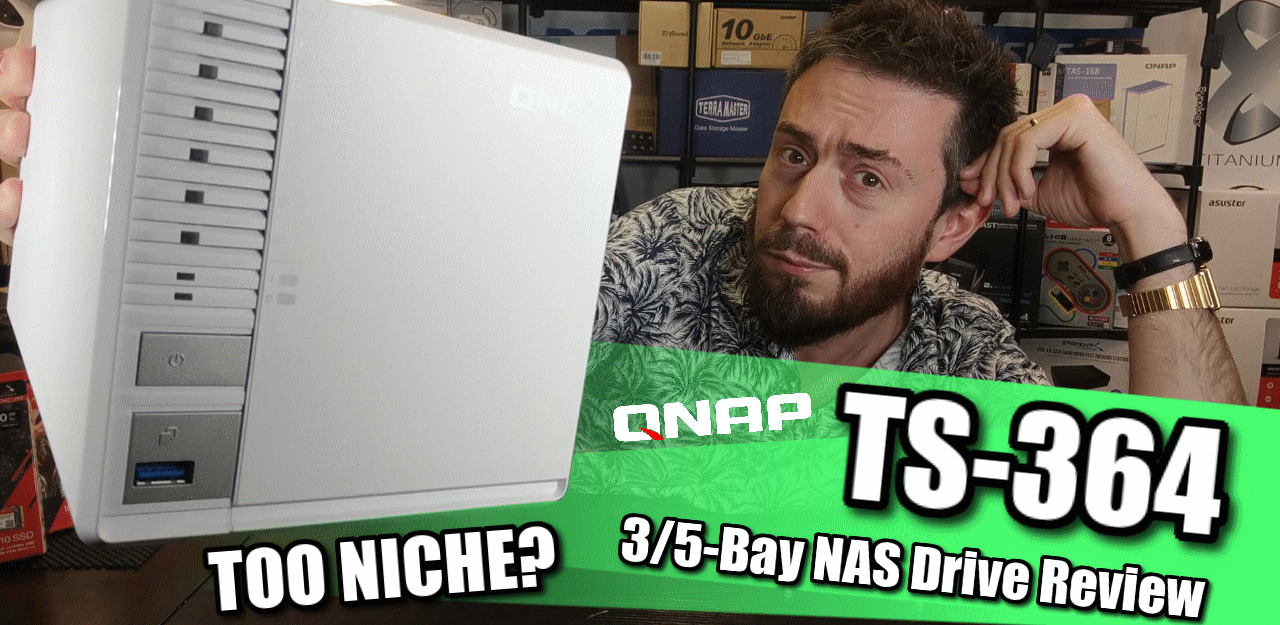




Hi there, thanks for the great video! I know this topic is about six years old, but I’m curious—have you ever managed to enable HDMI output passthrough for your Windows 11 VM on the TS-464? Right now I’m stuck with the default QXL 2.0 output, but I’d love to pass the VM’s graphics straight through to the NAS’s HDMI port. Do you know if that’s possible
REPLY ON YOUTUBE
why do they say that the 8gb is non expandable if there is an empty slot?
REPLY ON YOUTUBE
How is this as a plex media server?
REPLY ON YOUTUBE
Qnap licensing are going to be their killer. They should at least make it free for home use.
REPLY ON YOUTUBE
I’m confused by the review (written one). You state that gen 3x 2 is a downside but that’s twice the lanes of the ts-464 or the 462… granted there’s no pcie but surely the native M2s are quicker no?
REPLY ON YOUTUBE
I know this is an old thread, but I wanted to put a warning out there for anyone looking at the TS-364 8G. I’ve had this NAS for 14 months now and have had nothing but problems with it. To their credit, QNAP technical support has been responsive and worked to resolve the problems, but this has not resolved the core issue which, I think, is problem with the hardware. The unit fails in many ways and often becomes unavailable via Qfinder without cause. I’ve asked QNAP to replace the unit under warranty but they have refused saying that as long as technical support is able to get the NAS working again there is no warranty issue. I would estimate that the unit is down about 25% of the time. I’m using it for basic media storage (photos and video).
REPLY ON YOUTUBE
can this sync dropbox teams folders?
REPLY ON YOUTUBE
Qnap states on their Website that the TS-364 is “High End” Home NAS vs the TS-433 is “Middle-Range” Home NAS. What do you think how they are different from each other besides the missing 2 x M.2 2280 PCIe Gen 3 x2 slots, RAM and CPU Difference vs the additional 4th drive Bay? Would you rather go for the obvious more powerful 3Bay NAS or the ability to use a 4th HDD?
REPLY ON YOUTUBE
How do I know if the disks are spinning down? In the manual on the led section it mentions nothing about it…
REPLY ON YOUTUBE
Can those 2 ssd work like Apple function drive ? So user can raid 1 2 ssd and raid 5 3 hdd and get the most out of read and white form the ssd and safety for raid 5 ?
REPLY ON YOUTUBE
There is no way you will get this for anywhere near 350 price point try 450+
REPLY ON YOUTUBE
Can the 1 touch backup work for a phone?
REPLY ON YOUTUBE
What about stability between the two?
REPLY ON YOUTUBE
I am confused, does it have…
M.2 2280 PCIe Gen 3 *x2* slots
or
M.2 2280 PCIe Gen 3 *x4* slots
Hardware specs say *x2*
compatibility list suggests *x4*
REPLY ON YOUTUBE
I would really like to buy this nas, but I cannot find it anywhere for sale.
REPLY ON YOUTUBE
Gremlins
REPLY ON YOUTUBE
I guess I’m not the only one who has had some Gremlins in my NAS…
REPLY ON YOUTUBE
LOL love the gremlins reference.
Thanks for the amazing content, I have only discovered your channel but I’m slowly binge watching as much as I can.
REPLY ON YOUTUBE
Thanks for all your great videos – I am looking to upgrade my NAS and have settled on a Qnap TS-673A it will be my “home” NAS should I use QTS Hero ZFS or QTS 5 as my OP? Which is best? One of the main things I want to use is MyCloudLink (which I presume I can use on both OP)
REPLY ON YOUTUBE
Gremlims
REPLY ON YOUTUBE
I have some **GREMLINS** inside my Synology DS218+ 🙂
REPLY ON YOUTUBE
Gremlins in the system are always hard to find 😉
REPLY ON YOUTUBE
The gen 2 usb ports are on the back so you can use these for expansion units – they have not updated their tr002 and tr004 units to usb 3.2 gen 2 but once they do, you can expand the system nicely.
REPLY ON YOUTUBE
Gremlins!
REPLY ON YOUTUBE
Gremlins
REPLY ON YOUTUBE
Gremlins
REPLY ON YOUTUBE
Thanks for sharing!
REPLY ON YOUTUBE
Just as you said. Ts-332x which I have, has 10gbe. I have no idea why this one doesn’t have that.
Maybe you could use usb adapter to use thoes fast usb to connect to network but if not then I will wait for next model that will have 10gbe.
REPLY ON YOUTUBE
Not the only one with GEMLINS in their Nas
REPLY ON YOUTUBE
Very thorough review!
REPLY ON YOUTUBE
I could use a new NAS, mine has many Gremlins
REPLY ON YOUTUBE
Gremlins
REPLY ON YOUTUBE
As a new user you really make what was looking like a dive into the matrix, into something that I can actually folow. Thank you
REPLY ON YOUTUBE
Interesting Nas thanks for the video. Movie is “Gremlins”
REPLY ON YOUTUBE
I have a few gremlins that are slowly eating away at my available storage. This one is very tempting as my first step into the NAS pool
REPLY ON YOUTUBE
Took a while but found them Gremlins.
REPLY ON YOUTUBE
Gremlins
REPLY ON YOUTUBE
Gremlins
REPLY ON YOUTUBE
My old hardware is starting to make some rather strange noises. Must be some GREMLINS making a mess.
REPLY ON YOUTUBE
So, my current DS218 is starting to get some GEMLINS and getting full so a DS420+ would be a great upgrade. All the way down here in the colony we are a long way away but love your reviews, comments, guides and weekly quick update. Keep up the good work !!
REPLY ON YOUTUBE
This makes for a good Christmas story; this tiny qnap Elf should eliminate the gremlins which Synology is imposing on its HDD
REPLY ON YOUTUBE
GREMLINS
REPLY ON YOUTUBE
Gremlins
REPLY ON YOUTUBE
Gremlins
REPLY ON YOUTUBE
Home Alone!
REPLY ON YOUTUBE
Gremlins
REPLY ON YOUTUBE
Gremlins
REPLY ON YOUTUBE
Great Video no GREMLINS here
REPLY ON YOUTUBE
GREMLINS!!!
REPLY ON YOUTUBE
Hope there are no GREMLINS on my next DS922+. 🙂
REPLY ON YOUTUBE
Some * GREMLINS * in my NAS are making me watch too many of your videos. 😉 But honestly you are doing great work. Very informative stuff and I am hooked. Keep it up.
REPLY ON YOUTUBE
Gremlins!
REPLY ON YOUTUBE
I am really curious as to why my comment seems to disappear .. I had a question regarding the recent headline “QNAP warns of new crypto-miner targeting its NAS devices”
REPLY ON YOUTUBE
gremlins! Hi from Oz!
REPLY ON YOUTUBE
Haven’t seen them gremlins yet!
REPLY ON YOUTUBE
Don’t feed the Gremlins
REPLY ON YOUTUBE
My money was on a Die Hard NAS reference but looks like “”””GREMLINS”””” got in there instead. Thank you for another honest and informative review.
REPLY ON YOUTUBE
I could use another Nas Gremlins
REPLY ON YOUTUBE
Gremlins
REPLY ON YOUTUBE
Allready know almost all about new 364 but not know about Gremlins 🙂
REPLY ON YOUTUBE
Gremlins!
REPLY ON YOUTUBE
Gremlins but not late on
REPLY ON YOUTUBE
Gremlins?
REPLY ON YOUTUBE
Gremlins
REPLY ON YOUTUBE
GREMLINS……dont feed it data after midnight
REPLY ON YOUTUBE
Gremlins of course
REPLY ON YOUTUBE
I have an older Qnap model currently set to raid 1, if I get this can I just slot the old disks in and I’ll find every file on those without doing anything? And then buy a third equal disk and upgrade to raid 5?
REPLY ON YOUTUBE
Gremlins NAS 🙂
REPLY ON YOUTUBE
Gremlins!! Gotta love gizmo…
REPLY ON YOUTUBE
Long as you don’t do a set up of the NAS past midnight you shouldn’t have any Gremlins issues…..though also make sure pets don’t knock any water on your NAS…..
REPLY ON YOUTUBE
Gremlins Gremlins Gremlins All for the love of Gremlins Thanks for the video @NASCompares Hope you have a great week my cat says Hi
REPLY ON YOUTUBE
Is that the Gremlins version?
REPLY ON YOUTUBE
Gremlins
REPLY ON YOUTUBE
As long as your clock is synced, you don’t have to worry about feeding the gremlins after midnight..
REPLY ON YOUTUBE
Gremlins!
REPLY ON YOUTUBE
I watched the gremlins last year for Christmas. Pretty cute movie
REPLY ON YOUTUBE
No Gremlins in that NAS!
REPLY ON YOUTUBE
Don’t feed them after midnight or you’ll get Gremlins.
REPLY ON YOUTUBE
I could use a new NAS, mine has too many Gremlins
REPLY ON YOUTUBE
Gremlins – very scary ????
REPLY ON YOUTUBE
Gremlins don’t give him any water 🙂
REPLY ON YOUTUBE
Looks like a white goods appliance, or a NAS that could’ve been released around 2005.
REPLY ON YOUTUBE
Dont get them wet (gremlins that is)
REPLY ON YOUTUBE
lol ..no more Gremlins
REPLY ON YOUTUBE
Unless I missed it, the 3 bay suddenly makes it possible to move from Raid 1 to Raid 5. So, a huge percentage jump in storage for a relatively small additional cost vs Raid 1.
REPLY ON YOUTUBE
Wow! That is one hideous looking device. Not sure who is this catered towards. It isn’t something I would want sitting on my desk that’s for sure.
REPLY ON YOUTUBE
Glad they worked out all the Gremlins, as I like to feed mine data after midnight. For those of us that don’t win, we have all won all of this great content! Thanks.
REPLY ON YOUTUBE
Dose qnap have some sort of hybrid raid ? That back up and save space.
REPLY ON YOUTUBE
Latest QTS 5 firmware update lost every user’s “home” folder when connecting via AFP in a finder window, only shared folders are shown. Even disabling and enabling home folders in users don’t take any effect. Only In browser UI the home folder is working properly.
REPLY ON YOUTUBE
I have TS253be and update to QTS 5.0 but NAS force me to initialize NAS (Reset NAS set up)
My raid was gone (Raid 1) while I Initialized NAS to start 5.0 and I try to back up my data to external hdd
but my 2nd disk was gone while back up I can recovery data 70% (Lost forever 30%) T.T
Do you have problem to upgrade like me?
REPLY ON YOUTUBE
Do you have an ETA for full release QuTS Hero 5.0?
REPLY ON YOUTUBE
I had to roll back.
5.0.0. gave me two weird issues.
1. The fans went to 100% and stuck there, regardless of any setting or actual system temp.
2. (And this one is really weird) IR remote button pushes would be registered twice, but only around 25-33% of the time.
I rolled back AND forward three times to check and double check these issues. I’m staying with 4.5.x until I know 5.x.x has the bugs ironed out.
REPLY ON YOUTUBE
i have found the file permission are better but….. in my case the everyone group has no rights assigned to it when checking on qnap.not denied not ro or rw. when you create a user via qnap and assign rights via windows. somewhere along the line everyone has now changed to denied access…..simply just remove anyone from the resource…but not the right way?
REPLY ON YOUTUBE
FULL Written Review of QNAP QTS 5 – https://nascompares.com/2021/10/08/qnap-qts-5-0-nas-software-review-worth-your-data/
01:50 – Disclaimers & Review Considerations
05:25 – Start – QTS Change of Focus
07:00 – QTS 5 vs QTS 4.5 GUI, Design, The Good, the Bad & the Awkward
10:13 – Responsiveness
10:44 – Things That Have Not Changed
11:30 – Security, Notifications & Control
14:25 – Control Panel
15:39 – Storage Manager
17:25 – Remote Mounting & Cloud Gateways
18:40 – File Management
20:30 – Multimedia Control & Sharing
27:00 – Storage Continued – Health & Checks
29:00 – Synchronization & Backup Tools
36:35 – Virtual Machines, Containers & Ubuntu VMs
41:05 – VMware, Hyper-V and SaaS Backups
43:14 – HDMI Services & HD Station
45:00 – Surveillance Tools & Services
49:00 – Licenses, Good & Bad
51:00 – QSirch, QFile, Teamviewer, Hybrid Mount and the Conclusion
REPLY ON YOUTUBE
Add chapters to this video
REPLY ON YOUTUBE
I have a TVS 873e when i seach for the upgrade to QTS 5 on the QNAP site it is not showing it for me. the highest firmware is 4,5,4 1800 am i not able to run V5?
REPLY ON YOUTUBE
Why the full release of QTS 5.0 is not arrived yet on TS-X53D series ?
REPLY ON YOUTUBE
awesome, perfect video as always; you’re the best source for nas – especially on qnap, i would say. Possessor of the – NOWADAYS pretty old – ts231+P and i still use it as my daily driver; with the new qts 5 now, seems even more faster
REPLY ON YOUTUBE
That robot reminds me of the old MS office “clippy”… Luckily he doesn’t ask “it appears you are trying to…” ????
REPLY ON YOUTUBE
That robot in the corner…. Reminds me of clippy… kill it with fire!
REPLY ON YOUTUBE
How did you get this installed on a TVS-872X? I am trying to get it on my TVS-872XT and this model is not officially supported on this initial 5.0 release.
REPLY ON YOUTUBE
First! Always love the content!
REPLY ON YOUTUBE